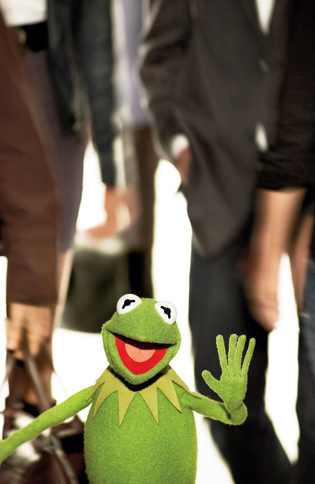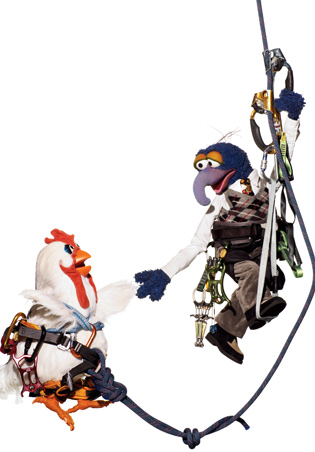Source:

Swat flies! Swat flies! (Photo: Art Streiber; set stylist: )
The Scientific Way to…
Swat Flies
Flies are like little ninjas, dodging even the most skillfully wielded rolled-up magazine. Michael Dickinson, a neurobiologist at the University of Washington, wanted to know how they pull this off. He got flies to climb through a tiny tube ending at a 5-millimeter-wide stage. Over it loomed a black disc that would descend from various angles when triggered. Meanwhile, a video camera recorded the encounter at thousands of frames per second. The flies, which have a nearly 360-degree field of view, are always on guard, and within 200 milliseconds of spotting a threat, they began a series of postural adjustments in advance of, well, flying. You can’t beat that speed. So to crush flies professionally, you have to predict their moves. — Judy Dutton
Method #1. From the front
If the crushing blow approaches head-on, the fly shifts its middle legs forward so it can push backward. Anticipate the backward jump by angling the swatter to arc over and then behind the fly.
Method #2. From behind
Perceiving a threat coming from behind, the fly moves its middle legs backward in preparation to launch forward. To land the swat, you have to lead the fly “like a quarterback leading a receiver,” Dickinson says.
Navigate a Crowd
Exiting a concert or ball game seems to take far longer than entering one. But because crowds can be highly predictable, it’s possible to outsmart the masses. Walk this way.—Katharine Gammon
 Aim for the outside
Aim for the outside
The outer edges of crowds generally move faster than the sludgy middle of the pack. A researcher in London studied such so-called edge effects by making videos of groups of people squeezing through corridors of various sizes. Sure enough, people tended to move faster along the walls. Other studies suggest why: People start bumping into each other when crowd density reaches around 7 to 10 square feet per person—something that usually happens in the denser middle area—and that jams the flow.
Take the express lane
People naturally form lines when walking in crowds. It’s generally good to stay in one of these lines rather than race ahead, which might force others to put on the brakes. “There’s a lot of self-organization in crowds, but the problems come when people transition from a flow to stop-and-go—then things get turbulent” says Dirk Helbing, who studies social behavior at the Swiss Federal Institute of Technology in Zurich.
Look ahead
One of the best ways to navigate through a crowd is to lead with your eyes: Look directly ahead, which allows others to see clearly where you want to go. If you keep your gaze fixed, others will instinctively get out of the way. Finnish researchers found that people register cues from others’ eyes, not body position, to avoid head-on collisions.
Turn that crap down! Playing your favorite music in the background may make it harder to study or acquire a new skill.
(Applied Cognitive Psychology)
Get in Shape
We could all use a little exercise. The question is, just how little? A recent study at the Queen’s University in Kingston, Ontario, found that everyday movements can contribute significantly to healthy heart function. So do a little more housework. Instead of sending emails to coworkers, get up and walk over to their desks. Take the stairs. Or just stand up and sit down a lot. There. You’ve worked out. — Erin Biba

Eat Spaghetti
 One of the occupational hazards of eating pasta is the way it slings sauce on everything around you—shirts, jacket … dates. Physicists creatively named this the spaghetti effect, the tendency of long flexible strands (like spaghetti) to whip side to side when pulled into a container (like your mouth). It’s a mild annoyance at dinner but a real danger in industrial settings where ropes or chains are rapidly pulled to and fro—or at home, when your metal tape measure goes feral. Fortunately, you can tame the noodle. — Judy Dutton
One of the occupational hazards of eating pasta is the way it slings sauce on everything around you—shirts, jacket … dates. Physicists creatively named this the spaghetti effect, the tendency of long flexible strands (like spaghetti) to whip side to side when pulled into a container (like your mouth). It’s a mild annoyance at dinner but a real danger in industrial settings where ropes or chains are rapidly pulled to and fro—or at home, when your metal tape measure goes feral. Fortunately, you can tame the noodle. — Judy Dutton
Why it whips
Slurping the spaghetti strand into your mouth applies kinetic energy. But it also shortens the length of the strand outside your mouth. So the energy gets concentrated, which turns the noodle into a bullwhip.
You could try…
Coiling the spaghetti around a fork and putting the whole thing in your mouth at once. This approach has the advantage of being dignified.
But it’s more fun to…
Cut the strand before putting it in your mouth. Or break the spaghetti in half before boiling so the shorter strands will whiplash less. You can still slurp as loud as you want. Just go slow to keep the kinetic energy down.
Find a Soul Mate
There’s a probabilistic approach to finding the love of your life, and it even has a name: satisficing, a combination of satisfy and suffice. OK, technically, satisficing refers to getting a good enough outcome when you’re lacking complete information about your options. But isn’t dating like that? According to Peter Todd, professor of informatics and cognitive science at Indiana University, the question always comes down to this: “Do you keep searching and hope something better will come along, or do you stop searching when you find something that looks pretty good?”
In the face of this conundrum, the best strategy for picking a mate is to date enough people to establish some baseline standards, then settle down with the next person you meet who exceeds the bar. According to Todd, you should have a baseline after dating roughly 12 people. He’s dubbed this theory the Twelve-Bonk Rule, and it can also be applied to picking the right employee or choosing a home. So, if you’ve dated fewer than 12 people, you should feel free to keep looking. If you’ve had 30 relationships, odds are you’re being too picky. Quit obsessing over your new paramour’s dorky laugh.— Judy Dutton
Fix a Credit Card That Won’t Swipe
A credit card is like a cassette tape. And just as your old copy of Van Halen II got fuzzy after hundreds of repeat performances, a credit card slowly gets garbled from overswiping. The reason: Both the tape and the magnetic stripe on the card are made up of millions of iron-oxide particles that convey information by generating electrical pulses in the reader. With wear, these particles get smeared, creating background noise. Luckily, this noise has very low magnetism, and it can be dampened by increasing the space between the magnetic stripe and the head that reads it. So simply cover the stripe with Scotch tape. If only reviving David Lee Roth’s career were that easy. — Judy Dutton
If you can’t remember the item before this one, you should get outside more. Taking a nature walk improves short-term memory.
(Psychological Science)

Cool Off
Man, is it nice to cool off with an ice-cold drink on a hot day. Nice, but pathetically inefficient. According to multiple studies, the faster way to cool your core is to strip naked and mist your entire body with lukewarm water while standing in front of a fan blowing warm air.
The magical result: Heat quickly transfers from your core into the surrounding air and water vapor—water is about 25 times more effective than air at conducting heat. Why not frigid water and air? Because the more temperate microclimate promotes evaporation, which is what cools you off. The technique will chill you out by up to 0.6 degrees Fahrenheit per minute.
Got ice? A more equipment-intensive method can also work for rapid cooling: Jump into an ice bath like athletes do. If you don’t have a chilled Jacuzzi handy, you can also use bags of ice to supercool your heat-sensitive parts—your groin, wrists, armpits, neck, and ankles—while misting in the buff. (Yes, you can still grab a cool drink when you’re done.) — Katharine Gammon
Remove Common Stains
Sprinting to the dry cleaner’s isn’t the only way to save your wine-splattered suit. All you need is a crash course on the chemistry hiding in your kitchen cupboards.*—Judy Dutton
Red wine
Remove it with: Club soda or baking soda
Why it works: Red wine contains tannic acid, while the carbon dioxide in club soda or baking soda creates a basic solution when dissolved in water. Acids and bases are attracted to each other, so when carbon dioxide comes cruising by, it lures the tannic acid away from the fabric it’s clinging to so it can easily be flushed away with water.
Dirt or rust
Remove it with: Lemon or vinegar
Why it works: Dirt and rust are alkaline or basic, while lemon and vinegar are acidic. Yet again, the acid/base cancellation policy applies (see above). It’s an especially useful trick in the case of rust, which is iron oxide and is insoluble in water. Introduce an acid into the mix and it interacts with the iron oxide, causing small particles to break away from the fabric.
Ink
Remove it with: Hair spray or rubbing alcohol
Why it works: The ethyl alcohol found in both hair spray and rubbing alcohol is a surfactant, which means that one side of the molecule is hydrophilic (or water-loving) while the other side loves organic molecules, like the carbon that serves as the pigment in ink. Because of this, ethyl alcohol acts as a liaison between water and ink so they exit your clothes together.
Blood
Remove it with: Salt water
Why it works: Blood contains hemoglobin, which is part iron and gives blood its red color. Salt displaces the iron in hemoglobin, causing the red color to fade. Meanwhile, the water keeps the blood wet and cold, preventing the hemoglobin from binding tightly with the fabric. And once you have iron, sodium, and chloride ions floating around together in liquid, it’s all ready to be washed away.
*Thanks to Bob Kenworthy at the Chemical Heritage Foundation
Apple juice: cloudy or clear? Cloudy. It has four times the concentration of the antioxidant polyphenol.
(Journal of the Science of Food and Agriculture)
Dunk a Cookie in Milk
The classic combo of milk and cookies too often ends in tragic failure. Dunkers keep their confection submerged too long, and the cookie breaks apart, sinking to the bottom of the glass in a useless slurry. In 1998, an advertising firm asked Len Fisher, a visiting fellow in physics at the University of Bristol, England, to try to crack this problem. Fisher realized there was already a mathematical formula called the Washburn equation that could be used to optimize cookie-dunking:

This formula describes capillary flow in porous materials, with t being the time for a liquid of viscosity η and surface tension γ to penetrate a distance L into a cookie of average pore diameter D. Or, as Fisher puts it in plain English: “Your problem with dunking is if you want to get the milk in, you have to let the holes and channels of the biscuit suck it in, which means you’ve got to give it time for that to happen. On the other hand, the biscuit is basically lumps of starch glued together with sugar, so if you let it sit in milk for too long, the biscuit will fall apart.”
Using this equation, Fisher found that you should dunk a cookie 3.5 to 5 seconds. That’s enough time for it to suck in liquid, but not enough time for it to dissolve. Also, how you dunk makes a difference. Fisher found that if you dunk the cookie fairly flat so that only one side gets wet, it will last four times as long—14 to 20 seconds—as a vertically dunked cookie. Admittedly, dipping the “scientific” way has a higher degree of difficulty (and looks insane). But in experiments in which he ate milk and cookies with a plastic tube stuck up his nose to analyze the gases wafting up from his palate, Fisher found that the more milk a cookie held, the better its “flavor release.” In plain English: The longer you dunk, the better your cookie tastes.— Judy Dutton
Be Happy
Do good deeds
Researchers at UC Riverside found that performing acts of kindness makes people happier. Unless, that is, the acts become repetitive tasks.
Get exercise
According to research at the Karolinska Institute in Stockholm, exercise has the same kind of physical effects on the brain as antidepressants.
Get hugged
Penn State researchers found that students who were hugged frequently were happier than students who weren’t.
Get a pet
Studies done at Miami University show that pets are as good at providing social support as other humans.

Rekindle Your Relationship
 Sooner or later, most relationships fall into a rut. Advice abounds on how to spice things up (cue the furry handcuffs). But the scientifically vetted solution for making sparks fly is much simpler, says Arthur Aron, a psychology professor at the State University of New York, Stony Brook. Aron set up an experiment in which couples roll a ball across a room toward each other, which they did with ease. He assigned other couples a similar task but with their hands and feet tied. Afterward, Aron asked everyone to complete questionnaires on how much they loved their partners. The bound couples reported being much more smitten than the unfettered ones, whose task was easier.
Sooner or later, most relationships fall into a rut. Advice abounds on how to spice things up (cue the furry handcuffs). But the scientifically vetted solution for making sparks fly is much simpler, says Arthur Aron, a psychology professor at the State University of New York, Stony Brook. Aron set up an experiment in which couples roll a ball across a room toward each other, which they did with ease. He assigned other couples a similar task but with their hands and feet tied. Afterward, Aron asked everyone to complete questionnaires on how much they loved their partners. The bound couples reported being much more smitten than the unfettered ones, whose task was easier.
No, this doesn’t take us back to furry handcuffs. The moral of Aron’s experiment is actually this: Take on a new challenge and the excitement of tackling it will rub off on your relationship. “That exhilarating feeling may come from another source, but it’s still associated with your partner,” says Aron, who theorizes this happens because of brain chemistry. “When people fall in love, they get activation in the dopamine system,” he says. Novel or exciting pursuits also stimulate the brain to pump out more dopamine. Aron theorizes that even playing videogames together may draw a couple closer. (Who knew Grand Theft Auto could help your love life?)
One easy way to put this wisdom to work is to shake up date night, suggests Aron, who conducted another experiment in which he asked couples to spend 90 minutes a week doing unfamiliar activities like rock climbing or taking Italian lessons. Ten weeks later, when these couples filled out a questionnaire about how they felt about each other, they scored much higher than couples who had stuck to familiar date nights like dinner and a movie. Problema risolto! — Judy Dutton
Ace a Test
You’ve studied. You’ve taken practice exams. You’ve gotten a good night’s sleep. there’s only one thing left to do before that big test: Get some exercise. According to experiments conducted at the University of Illinois at Urbana-Champaign, one of the best things you can do to prep your brain for an intellectual challenge is to get in a perfectly timed small workout. Here’s how to sweat your way to a better score. — Brendan I. Koerner
Consider a Treadmill
You need to get your heart racing to sharpen your cognition, but you don’t want to risk overtaxing your mind. So avoid athletic pursuits against opponents—even virtual ones. One study found that treadmill workouts improve mental performance but vigorous sessions of Wii games do not.
Hit the Sweet Spot
Avoid either under- or overexertion: Taking it too easy will leave you as dull as when you started, and overdoing it will make you too tired to focus. Aim for a heart rate of about 60 percent of max. Use a heart-rate monitor to make sure you keep that same exertion plateau for a full 20 minutes.
Timing Is Everything
The cognitive benefits don’t kick in the moment you hop off the treadmill. Ongoing research suggests it will be anywhere from five to 20 minutes before they take effect. So time your workout to end about 20 minutes before the proctor yells, “Go!”
Strategize
The cognitive boost can be short-lived. After about 50 minutes researchers saw a return to baseline. So tackle the hardest questions first—remember, they’re often placed at the end of each section.
The more you chew, the less you eat. Chewing your food lowers levels of the hormone ghrelin, associated with hunger.
(The American Journal of Clinical Nutrition)
Microwave Food Evenly
 Nothing is as fickle as a microwaved burrito. One bite scorches the tongue; the next turns up a cold lump of bean and cheese. To better understand this paradox, in 2002 Suvi Ryyn?nen, a researcher in the department of food technology at the University of Helsinki, inserted thermometer probes into various points of prepackaged meals before nuking them. After cooking, Ryyn?nen found the difference between the hottest and coldest spots to be greater than 150 degrees—a range sure to flummox even the most ardent consumer of microwavable food.
Nothing is as fickle as a microwaved burrito. One bite scorches the tongue; the next turns up a cold lump of bean and cheese. To better understand this paradox, in 2002 Suvi Ryyn?nen, a researcher in the department of food technology at the University of Helsinki, inserted thermometer probes into various points of prepackaged meals before nuking them. After cooking, Ryyn?nen found the difference between the hottest and coldest spots to be greater than 150 degrees—a range sure to flummox even the most ardent consumer of microwavable food.
The reason hot spots happen is because the waves in microwaves have peaks (high points) and troughs (low points). As these waves bounce around inside the oven, they often meet, resulting in a phenomenon called interference. When a peak meets a peak, they create an even bigger peak, frying food in that area. When a peak meets a trough, they cancel each other out, leaving food cold. The key to avoiding these land mines is to know where the hot spots are hiding. How? Cook a tray of marshmallows in your oven. In the hot spots, “the marshmallows puff up and melt, and in the cold spots the marshmallows don’t change much,” says Lou Bloomfield, professor of physics at the University of Virginia. If there are too many hot spots, your best strategy is to keep your food moving, which is why most microwaves have turntables (one study showed these can increase the temperature uniformity by 40 percent). Don’t make the mistake, however, of placing your food in the center. Since food here just spins on its axis, it’s not moving much, which means you could be burning a Chernobyl-sized hole through your pastrami sandwich. Instead, place your food along the turntable’s edge.— Judy Dutton
Plan a Party
In 1959, physicist William MacLean at the Polytechnic Institute of Brooklyn, New York, published a study, “On the Acoustics of Cocktail Parties.” In it, he pointed out that the noise you hear at a social gathering has two sources: the direct sound from, say, a person who’s speaking and the indirect sound that arrives at your ears after bouncing off the walls, furniture, and other guests. The noise level will remain manageable as long as speakers can be heard over the background noise. As soon as indirect sound exceeds direct sound, though, people will begin to raise their voices, starting a chain reaction that will cause the volume in the room to skyrocket.
To avoid such eruptions, you must invite the right number of guests. Arianna Astolfi, a researcher at Politecnico di Torino in Italy, studied noise levels in a local pizzeria. She found that when there were 18 people in the 42-square-meter eatery, conversation stayed at reasonable levels. But when the restaurant was packed with 36 guests, the volume rose to the point that people started to raise their voices. Based on her calculations, Astolfi says, if you want to throw a party where guests can hear each other and won’t attract noise complaints, invite no more than one person for every 21 square feet, or about 24 people for a 500-square-foot room.— Judy Dutton

Walk on the Moon
 Learn to lope
Learn to lope
Loping is just about the easiest gait out there—put one foot in front of the other, and push off the back foot to rock onto the front foot. MIT’s Christopher Carr says that loping comes naturally to kids (loping is easier than skipping, so kids learn it early), vampire bats (surprisingly, the bats are tetrapods that run with a lopelike gait), and (duh) astronauts.
Conserve energy
Carr and his colleagues found that loping—which doesn’t require the body to bend as much as running—gave their test subjects the most metabolic bang for their buck both with and without a simulated space suit. But things might be different on Mars: The Red Planet’s gravity is between the Moon’s and Earth’s, which means there’s no metabolic advantage to loping.
When in doubt, go faster
A separate piece of advice for lunar perambulators: If you need to get back to the lander in a hurry, run! Loping may be the most efficient stride on the moon, but it’s not necessarily the fastest. Carr calculated the difference between slow and fast gaits and concluded that running—or at least loping faster—could save your life. “Your metabolic rate will be higher, so you’ll go through oxygen more quickly,” he says. “But you’re also going to get there sooner.”
Gain Trust
Trust is something you earn. And to earn it, you must slowly and painstakingly build a relationship based on mutual admiration and respect. Only kidding! Trust can totally be faked. The key, as researchers at Vrije University Amsterdam discovered, is in convincing others that you have a high level of self-control. The researchers conducted a series of experiments on married couples as well as complete strangers in an effort to determine how trust forms. In each instance, people who exhibited self-control—who decided against buying CDs when they were short on cash, for example, or who showed up at places on time—were deemed trustworthy. So if you want people to trust you, just tell someone you are on a diet, then pass on dessert. Or promise to do a favor for them, then do it. And be on time. It works. Trust us. — Erin Biba
Stick with bent-shaft snow shovels this winter. You’ll bend less and clear snow more efficiently.
(Applied Ergonomics)
Work With Others
Looking out for number one is not a great survival strategy. We know this intuitively or we wouldn’t tip waiters or stop at red lights. Game theorists discovered years ago that cooperative strategies usually produce the most success. Computer models show that the top dog isn’t the most ruthless; it’s the one who reciprocates. Math proves the golden rule.
There were conditions, of course. If you’re “nice”—that is, if you cooperate—but your competition responds with lying or cheating, you have to retaliate. (Forgiveness is part of the equation, too, though. Slap the wrist and move on.)
The theory got more support when evolutionary biologists started noticing how important cooperation is to evolution. “If I am willing to let others have a slightly bigger share of the pie, then people will want to share pies with me,” wrote Harvard researcher Martin Nowak. “Generosity bakes successful deals.” In other words, a social group that plays by these rules becomes a kind of superorganism. (Like an ant colony—or Twitter.) That’s especially true in a globally integrated world. So unless you’ve got a ship packed for Mars, best to play nice.— K. C. Cole
Level a Picture
![]()
If pictures on a wall start a little crooked, they end up a lot crooked. Being slightly askew means their centers of gravity are lower than if they were straight, so over time, gravity pulls them even more off center. When a chance disturbance (like building vibrations or a door slamming) momentarily relieves the friction between the cord and the nail, the cord will slide slightly, nudging the lowest corner of the frame farther southward.
The simplest solution is just to use a longer cord to hang your picture. In effect, this turns it from a teetering seesaw into a swing that always settles at its lowest point. You can also cheat by using two nails. “This fools the picture into thinking it’s hanging from a long cord,” says Hugh Morton, a mathematician who specializes in knot theory at the University of Liverpool in the UK. “It will be very happy.” So that’s the cold calculation to make: Is doubling the number of holes in your wall worth never having to readjust the frames? — Judy Dutton
Keep Your Earbuds From Tangling
 No matter how carefully you place a pair of earbuds into your pocket, they emerge as a rat’s nest. Why? Dorian Raymer and Douglas Smith at UC San Diego unraveled the mystery in a paper titled “Spontaneous Knotting of an Agitated String” in Proceedings of the National Academy of Sciences. The researchers stuck lengths of string in a box, rotated the box, then opened it to see if knots formed. After an eye-glazing 3,415 trials, they determined that string shorter than 1.5 feet never tangled, but as a string gets longer, the probability of knots shoots up sharply (which is why 10-foot-long Christmas tree lights can melt your soul).
No matter how carefully you place a pair of earbuds into your pocket, they emerge as a rat’s nest. Why? Dorian Raymer and Douglas Smith at UC San Diego unraveled the mystery in a paper titled “Spontaneous Knotting of an Agitated String” in Proceedings of the National Academy of Sciences. The researchers stuck lengths of string in a box, rotated the box, then opened it to see if knots formed. After an eye-glazing 3,415 trials, they determined that string shorter than 1.5 feet never tangled, but as a string gets longer, the probability of knots shoots up sharply (which is why 10-foot-long Christmas tree lights can melt your soul).
Apple, never one to pass up an opportunity to hawk a new product, has patented a method to keep iPod earbuds from tangling by stiffening the wires so they can’t curl in on themselves so easily. In theory, this should help, although it’s not your only option. Robert Matthews at Aston University in Birmingham, England, hypothesized that he could cut down on knots by clipping the earbuds themselves to the miniplug, forming a loop. To test this theory he persuaded kids in eight schools to jumble clipped and unclipped string in boxes and report the results. Some 12,000 trials later, he found that looping reduced the risk of knots forming up to tenfold.
If you don’t have any binder clips, Smith suggests an approach he picked up from rescue squads who hang from cliffs and helicopters, where tangled rope could prove fatal. “They put one end of the rope into a bag, then feed the rest in, like you’d stuff a sleeping bag into its stuff sack,” Smith says. This keeps the ends away from each other, preventing knots from forming.— Judy Dutton

0
推荐




 京公网安备 11010502034662号
京公网安备 11010502034662号 